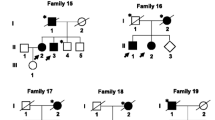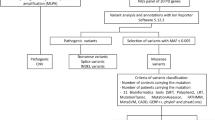Abstract
Functional and genetic studies have identified association between several Zinc finger (ZNF) proteins and Parkinson’s disease (PD). However, most of them were still awaiting further replications, especially in the Asian population. Here, we systematically selected PD-relevant ZNF genes and analyzed the genetic associations between these ZNFs and PD in a large Chinese PD cohort. We identified rare variants (minor allele frequency < 0.01) in 743 unrelated patients with early-onset PD (EOPD, age at onset < 50 years) using whole exome sequencing and evaluated the association between rare variants and EOPD at both allele and gene levels. Totally 91 rare variants were identified in ZNF746, ZNF646, ZNF184, ZNF165, ZND219, and GLIS1. One variant p.R373H in ZNF219 and two variants p.G161D and p.R158H in ZNF746 were significantly associated with EOPD, and gene-based burden analysis showed enrichment of rare variants of ZNF746 in EOPD. Our findings build up the connection between ZNF746 and PD from a genetic perspective for the first time, supplement current understanding for the genetic role of ZNFs in EOPD, and broaden the mutation spectrum in PD.

Similar content being viewed by others
Data availability
All data generated or analyzed in the study were included in the article and supplementary material.
Code Availability
Not applicable.
Abbreviations
- PD:
-
Parkinson’s disease
- EOPD:
-
Early-onset Parkinson’s disease
- ZNF :
-
Zinc finger
- GWAS:
-
Genome-wide association study
- WES:
-
Whole exome sequencing
- MAF:
-
Minor allele frequency
- gnomAD:
-
Genome aggregation database
References
Marinus J, Zhu K, Marras C, Aarsland D, van Hilten JJ (2018) Risk factors for non-motor symptoms in Parkinson’s disease. Lancet Neurol 17(6):559–568. https://doi.org/10.1016/s1474-4422(18)30127-3
Shachar T, Lo Bianco C, Recchia A, Wiessner C, Raas-Rothschild A, Futerman AH (2011) Lysosomal storage disorders and Parkinson’s disease: Gaucher disease and beyond. Mov Disord 26(9):1593–1604. https://doi.org/10.1002/mds.23774
Blauwendraat C, Nalls MA, Singleton AB (2019) The genetic architecture of Parkinson’s disease. Lancet Neurol 19:170–178. https://doi.org/10.1016/s1474-4422(19)30287-x
Lim SY, Tan AH, Ahmad-Annuar A, Klein C, Tan LCS, Rosales RL, Bhidayasiri R, Wu YR et al (2019) Parkinson’s disease in the Western Pacific Region. Lancet Neurol 18:865–879. https://doi.org/10.1016/s1474-4422(19)30195-4
Nalls MA, Blauwendraat C, Vallerga CL, Heilbron K, Bandres-Ciga S, Chang D, Tan M, Kia DA et al (2019) Identification of novel risk loci, causal insights, and heritable risk for Parkinson’s disease: a meta-analysis of genome-wide association studies. Lancet Neurol 18(12):1091–1102. https://doi.org/10.1016/s1474-4422(19)30320-5
Krishna SS, Majumdar I, Grishin NV (2003) Structural classification of zinc fingers: survey and summary. Nucleic Acids Res 31(2):532–550. https://doi.org/10.1093/nar/gkg161
Cassandri M, Smirnov A, Novelli F, Pitolli C, Agostini M, Malewicz M, Melino G, Raschellà G (2017) Zinc-finger proteins in health and disease. Cell Death Dis 3:17071. https://doi.org/10.1038/cddiscovery.2017.71
Chang D, Nalls MA, Hallgrimsdottir IB, Hunkapiller J, van der Brug M, Cai F, Kerchner GA, Ayalon G et al (2017) A meta-analysis of genome-wide association studies identifies 17 new Parkinson’s disease risk loci. Nat Genet 49(10):1511–1516. https://doi.org/10.1038/ng.3955
Foo JN, Chew EGY, Chung SJ, Peng R, Blauwendraat C, Nalls MA, Mok KY, Satake W et al (2020) Identification of risk loci for Parkinson disease in Asians and comparison of risk between Asians and Europeans: a genome-wide association study. JAMA Neurology 77:746–754. https://doi.org/10.1001/jamaneurol.2020.0428
Shin JH, Ko HS, Kang H, Lee Y, Lee YI, Pletinkova O, Troconso JC, Dawson VL et al (2011) PARIS (ZNF746) repression of PGC-1α contributes to neurodegeneration in Parkinson’s disease. Cell 144(5):689–702. https://doi.org/10.1016/j.cell.2011.02.010
Brahmachari S, Lee S, Kim S, Yuan C, Karuppagounder SS, Ge P, Shi R, Kim EJ et al (2019) Parkin interacting substrate zinc finger protein 746 is a pathological mediator in Parkinson’s disease. Brain J Neurol 142(8):2380–2401. https://doi.org/10.1093/brain/awz172
Clough RL, Dermentzaki G, Stefanis L (2009) Functional dissection of the alpha-synuclein promoter: transcriptional regulation by ZSCAN21 and ZNF219. J Neurochem 110(5):1479–1490. https://doi.org/10.1111/j.1471-4159.2009.06250.x
Song W, Chen YP, Huang R, Chen K, Pan PL, Li J, Yang Y, Shang HF (2012) GLIS1 rs797906: an increased risk factor for late-onset Parkinson’s disease in the Han Chinese population. Eur Neurol 68(2):89–92. https://doi.org/10.1159/000337955
Camargos ST, Dornas LO, Momeni P, Lees A, Hardy J, Singleton A, Cardoso F (2009) Familial Parkinsonism and early onset Parkinson’s disease in a Brazilian movement disorders clinic: phenotypic characterization and frequency of SNCA, PRKN, PINK1, and LRRK2 mutations. Mov Disord 24(5):662–666. https://doi.org/10.1002/mds.22365
Postuma RB, Berg D, Stern M, Poewe W, Olanow CW, Oertel W, Obeso J, Marek K et al (2015) MDS clinical diagnostic criteria for Parkinson’s disease. Mov Disord 30(12):1591–1601. https://doi.org/10.1002/mds.26424
Hughes AJ, Daniel SE, Kilford L, Lees AJ (1992) Accuracy of clinical diagnosis of idiopathic Parkinson’s disease: a clinico-pathological study of 100 cases. J Neurol Neurosurg Psychiatry 55(3):181–184. https://doi.org/10.1136/jnnp.55.3.181
Buniello A, MacArthur JAL, Cerezo M, Harris LW, Hayhurst J, Malangone C, McMahon A, Morales J et al (2019) The NHGRI-EBI GWAS Catalog of published genome-wide association studies, targeted arrays and summary statistics 2019. Nucleic Acids Res 47(D1):D1005–d1012. https://doi.org/10.1093/nar/gky1120
Li C, Ou R, Chen Y, Gu X, Wei Q, Cao B, Zhang L, Hou Y et al (2020) Mutation analysis of DNAJC family for early-onset Parkinson’s disease in a Chinese cohort. Mov Disord 35:2068–2076. https://doi.org/10.1002/mds.28203
Li C, Ou R, Chen Y, Gu X, Wei Q, Cao B, Zhang L, Hou Y et al (2020) Mutation analysis of TMEM family members for early-onset Parkinson’s disease in Chinese population. Neurobiol Aging. https://doi.org/10.1016/j.neurobiolaging.2020.11.005
Karczewski KJ, Francioli LC, Tiao G, Cummings BB, Alföldi J, Wang Q, Collins RL, Laricchia KM et al (2020) The mutational constraint spectrum quantified from variation in 141,456 humans. Nature 581(7809):434–443. https://doi.org/10.1038/s41586-020-2308-7
Auton A, Brooks LD, Durbin RM, Garrison EP, Kang HM, Korbel JO, Marchini JL, McCarthy S et al (2015) A global reference for human genetic variation. Nature 526(7571):68–74. https://doi.org/10.1038/nature15393
Wang K, Li M, Hakonarson H (2010) ANNOVAR: functional annotation of genetic variants from high-throughput sequencing data. Nucleic Acids Res 38(16):e164–e164. https://doi.org/10.1093/nar/gkq603
Pankratz N, Beecham GW, DeStefano AL, Dawson TM, Doheny KF, Factor SA, Hamza TH, Hung AY et al (2012) Meta-analysis of Parkinson’s disease: identification of a novel locus, RIT2. Ann Neurol 71(3):370–384. https://doi.org/10.1002/ana.22687
Sakai T, Hino K, Wada S, Maeda H (2003) Identification of the DNA binding specificity of the human ZNF219 protein and its function as a transcriptional repressor. DNA Res 10(4):155–165. https://doi.org/10.1093/dnares/10.4.155
Bendikov-Bar I, Rapaport D, Larisch S, Horowitz M (2014) Parkin-mediated ubiquitination of mutant glucocerebrosidase leads to competition with its substrates PARIS and ARTS. Orphanet J Rare Dis 9:86. https://doi.org/10.1186/1750-1172-9-86
Funding
This study was supported by the funding of the National Key Research and Development Program of China (Grant No. 2016YFC0901504); the 1.3.5 project for disciplines of excellence, West China Hospital, Sichuan University (No. ZYJC18038, No. ZYJC18003); the National Clinical Research Center for Geriatrics, West China Hospital, Sichuan University (Grant No. Z20192006); the Science Foundation of Chengdu Science and Technology Bureau (2019-YF05-00307-SN); and the Sichuan Science and Technology Program (Grant No. 2021YJ0415).
Author information
Authors and Affiliations
Contributions
ChunYu Li: design, execution, and writing. RuWei Ou: execution and writing. YongPing Chen: writing. XiaoJing Gu: blood samples collection. QianQian Wei: blood samples collection. Bei Cao: patients enrollment. LingYu Zhang: clinical data collection. YanBing Hou: patients enrollment. KunCheng Liu: clinical data collection. XuePing Chen: patients enrollment and clinical data collection. Wei Song: patients enrollment and clinical data collection. Bi Zhao: patients enrollment and clinical data collection. Ying Wu: patients enrollment and clinical data collection. Yi Liu: writing. HuiFang Shang: design, conception, and review.
Corresponding authors
Ethics declarations
Ethics Approval and Consent to Participate
This study protocol was approved by the ethics committee of West China Hospital, Sichuan University. All participants have signed informed consent.
Consent for Publication
Not applicable.
Conflict of Interest
The authors declare no competing interests.
Additional information
Publisher’s Note
Springer Nature remains neutral with regard to jurisdictional claims in published maps and institutional affiliations.
Supplementary Information
ESM 1
(PDF 416 kb)
Rights and permissions
About this article
Cite this article
Li, C.Y., Ou, R.W., Chen, Y.P. et al. Genetic Analysis of ZNF Protein Family Members for Early-Onset Parkinson’s Disease in Chinese Population. Mol Neurobiol 58, 3435–3442 (2021). https://doi.org/10.1007/s12035-021-02354-5
Received:
Accepted:
Published:
Issue Date:
DOI: https://doi.org/10.1007/s12035-021-02354-5




